engine SKODA SUPERB 2009 2.G / (B6/3T) Owner's Guide
[x] Cancel search | Manufacturer: SKODA, Model Year: 2009, Model line: SUPERB, Model: SKODA SUPERB 2009 2.G / (B6/3T)Pages: 294, PDF Size: 21.33 MB
Page 107 of 294
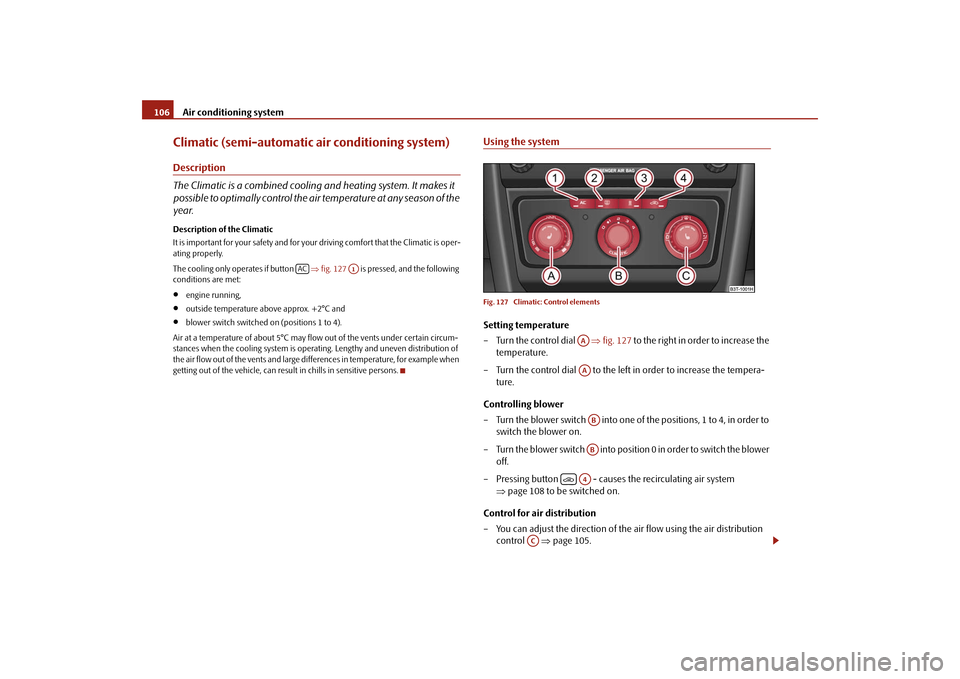
Air conditioning system
106
Climatic (semi-automatic air conditioning system)Description The Climatic is a combined cooling and heating system. It makes it possible to optimally control the air
temperature at any season of the
year.Description of the Climatic It is important for your safety and for your driving comfort that the Climatic is oper- ating properly. The cooling only operates if button
⇒fig. 127
is pressed, and the following
conditions are met:•
engine running,
•
outside temperature above approx. +2°C and
•
blower switch switched
on (positions 1 to 4).
Air at a temperature of about 5°C may flow
out of the vents under certain circum-
stances when the cooling system is operating. Lengthy and uneven distribution of the air flow out of the vents and large differences in temperature, for example when getting out of the vehicle, can resu
lt in chills in sensitive persons.
Using the systemFig. 127 Climatic: Control elementsSetting temperature – Turn the control dial
⇒
fig. 127
to the right in order to increase the
temperature.
– Turn the control dial to the left in order to increase the tempera-
ture.
Controlling blower – Turn the blower switch into one of
the positions, 1 to 4, in order to
switch the blower on.
– Turn the blower switch into positi
on 0 in order to switch the blower
off.
– Pressing button - causes
the recirculating air system
⇒
page 108 to be switched on.
Control for air distribution – You can adjust the direction of the air flow using the air distribution
control
⇒
page 105.
AC
A1
AAAAABAB
A4
AC
s2dk.1.book Page 106 Wednesday, April 8, 2009 12:23 PM
Page 110 of 294

Air conditioning system
109
Using the system
Safety
Driving Tips
General Maintenance
Breakdown assistance
Technical Data
Climatronic* (automatic air conditioning)Description The Climatronic system is a combin
ation of an automatic heating,
fresh air and cooling system which provides optimal comfort for the occupants of the car.The Climatronic maintains fully automatically a convenience temperature. This is achieved by automatically varying the temperature of the outflowing air, the blower stages and the air distribution. The system also takes into account sunlight which eliminates the need to alte
r the settings manually. The
automatic mode
⇒ page 110 ensures maximum wellbeing of th
e occupants at all times of the year.
Description of Climatronic system The cooling operates only if the following conditions are met:•
engine running,
•
outside temperature above approx. +2°C,
•
switched on.
The AC compressor is switched off at a hi
gh coolant temperature in order to provide
cooling at a high load of the engine. Recommended setting for al
l periods of the year:
•
Set the desired temperature, we recommend 22 °C.
•
Press the button
⇒fig. 128
.
•
Move the air outlet vents
2 and
3 so that the air flow is directed slightly upwards.
Aeration of the vehicle when ignition is switched off* On vehicles fitted with power sliding/tilting roof with solar cells* the fresh air blower is automatically switched over to “solar mode” if the sun rays are sufficient after switching off the ignition. The solar
cells on the sliding/tilting roof deliver
power for the fresh air blower
. This supplies the interior of the car with fresh air.
For an optimum ventilation, the air outlet vents
2 and
3 must be opened
⇒ page 105, fig. 125
.
The ventilation functions only when the sliding/tilting roof is closed.
Note
On vehicles equipped with a
factory-fitted radio* or navi
gation*, the information of
the Climatronic is also shown on the display. This function can be switched off, see operating instructions of the ra
dio* or the navigation system*.
Overview of the control elements The controls enable a separate setting of the temperature for the left and right side.Fig. 128 Climatroni
c: Control elements
The buttons
Defrost windscreen intensively Air flow to the windows Air flow to head Air flow in the footwell Recirculated air mode with air quality sensor Rear window
heater
Buttons / control dial
AC
AUTO
A1
A2
A3
A4
A5
A6
s2dk.1.book Page 109 Wednesday, April 8, 2009 12:23 PM
Page 113 of 294
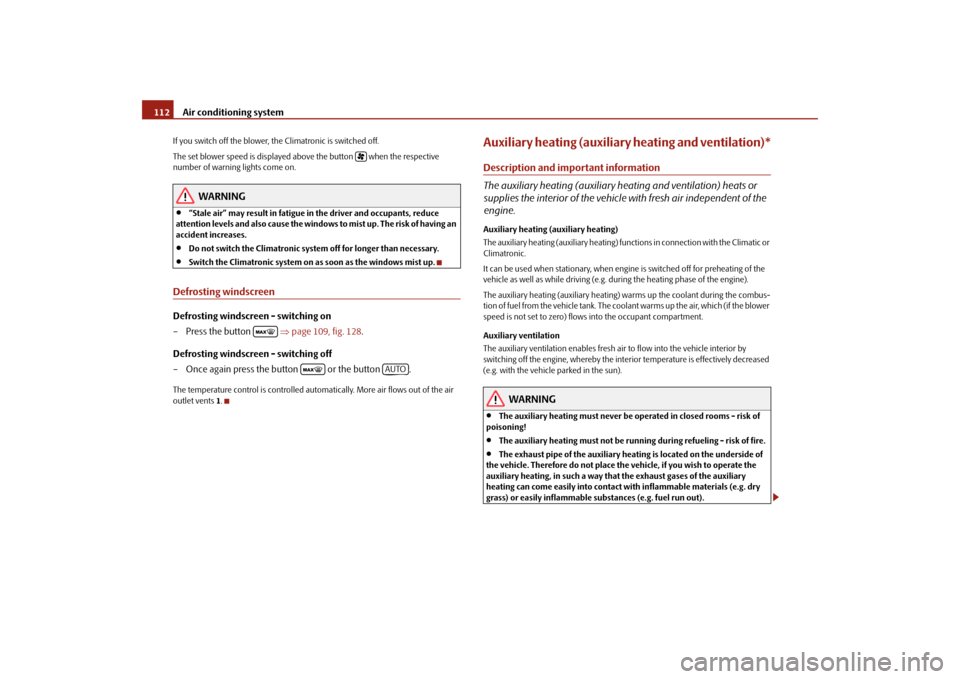
Air conditioning system
112
If you switch off the blower, the Climatronic is switched off. The set blower speed is displayed above the button when the respective number of warning lights come on.
WARNING
•
“Stale air” may result in fatigue in the driver and occupants, reduce
attention levels and also cause the windows to mist up. The risk of having an accident increases.•
Do not switch the Climatronic system off for longer than necessary.
•
Switch the Climatronic system on as soon as the windows mist up.
Defrosting windscreenDefrosting windscreen - switching on – Press the button
⇒
page 109, fig. 128
.
Defrosting windscreen - switching off – Once again press the butt
on or the button .
The temperature control is controlled automa
tically. More air flows out of the air
outlet vents
1.
Auxiliary heating (auxiliary heating and ventilation)*Description and important information The auxiliary heating (auxiliary heating and ventilation) heats or supplies the interior of the vehicle with fresh air independent of the engine.Auxiliary heating (auxiliary heating) The auxiliary heating (auxiliary heating) func
tions in connection with the Climatic or
Climatronic. It can be used when stationary, when engi
ne is switched off for preheating of the
vehicle as well as while driving (e.g. during the heating phase of the engine). The auxiliary heating (auxiliary heating)
warms up the coolant during the combus-
tion of fuel from the vehicle tank. The cool
ant warms up the air, which (if the blower
speed is not set to zero) flows
into the occupant compartment.
Auxiliary ve
ntilation
The auxiliary ventilation enables fresh air
to flow into the vehicle interior by
switching off the engine, whereby the interior temperature is effectively decreased (e.g. with the vehicle parked in the sun).
WARNING
•
The auxiliary heating must never be op
erated in closed rooms - risk of
poisoning!•
The auxiliary heating must not be runn
ing during refueling - risk of fire.
•
The exhaust pipe of the auxiliary heating is located on the underside of
the vehicle. Therefore do not place th
e vehicle, if you wish to operate the
auxiliary heating, in su
ch a way that the exhaust gases of the auxiliary
heating can come easily into contact
with inflammable materials (e.g. dry
grass) or easily inflammable su
bstances (e.g. fuel run out).
AUTO
s2dk.1.book Page 112 Wednesday, April 8, 2009 12:23 PM
Page 114 of 294

Air conditioning system
113
Using the system
Safety
Driving Tips
General Maintenance
Breakdown assistance
Technical Data
Note
•
If the auxiliary heating runs, the fuel
consumption comes from
the vehicle tank.
Therefore the auxiliary heating should not be operated, if there is very little fuel in the tank.•
The exhaust pipe of the auxiliary heating,
which is located on the underside of
the vehicle, must not be clogged and the exhaust flow must not be blocked.•
If the auxiliary heating and ventilation is
running, the vehicle battery discharges.
If the auxiliary heating and ventilation
has been operated several times over a
longer period, the vehicle must be driven
a few kilometers in order to recharge the
vehicle battery.•
The auxiliary heating only sw
itches the blower on, if
it has achieved a coolant
temperature of approx. 50 °C.•
At low outside temperatures, this can resu
lt in a formation of water vapour in
the area of the engine compartment.This
is quite normal and is not an operating
problem.•
After switching off the auxiliary heating, the coolant pump runs for a short
period.•
The auxiliary heating and ventilation does not switch on or comes on, if the
vehicle battery indicate
s a low loading state.
•
The auxiliary heating (auxiliary heating) does not switch on, if the following was
shown in the information display or before switching off the ignition:
Please refuel!
(Please refuel!)
.
•
The air inlet in front of the windscreen must be free of ice, snow or leaves in
order to ensure that the auxiliary heating operates properly.•
So that warm air can flow into the vehi
cle interior after switching on the auxil-
iary heating, you must maintain the te
mperature normally selected by you (we
recommend 22°C). It is recommended to
put the air flow
in the position
.
•
On vehicles with DPF (diesel particle filter) the warm coolant heats up the
engine.
Direct switching on/offThe auxiliary heating (auxiliary heating and ve
ntilation) can be switched on or off at
any time
directly
using the button on the op
erating part of the Climatic
⇒ fig. 129
or on the operating part of the Climatronic.
If the auxiliary heating and ventilation is not switched off earlier, it switches off automatically after the expiration of
the set operating period, in the menu
Running
time
.
Fig. 129 Button for direct switching on/off of the auxil-iary heating (auxiliary heating and ventilation) on the operating part of the Climatic
s2dk.1.book Page 113 Wednesday, April 8, 2009 12:23 PM
Page 119 of 294
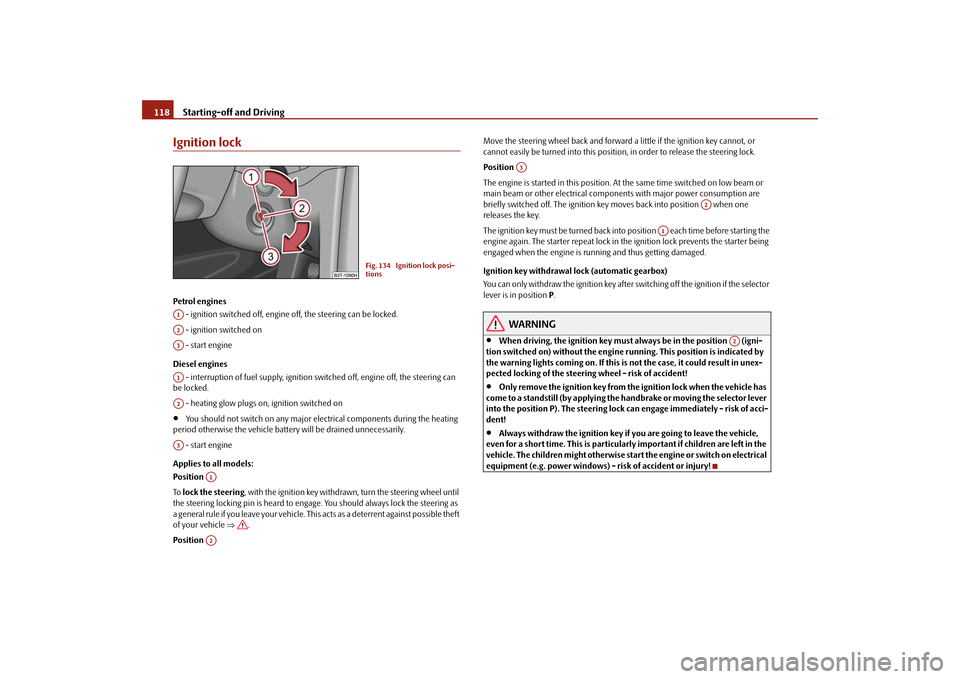
Starting-off and Driving
118
Ignition lockPetrol engines - ignition switched off, engine
off, the steering can be locked.
- ignition switched on - start engine Diesel engines - interruption of fuel supply, ignition sw
itched off, engine off, the steering can
be locked. - heating glow plugs on, ignition switched on•
You should not switch on any major elec
trical components during the heating
period otherwise the vehicle batt
ery will be drained unnecessarily.
- start engine Applies to all models: Position
To lock the steering
, with the ignition key withdrawn, turn the steering wheel until
the steering locking pin is heard to engage. You should always lock the steering as a general rule if you leave your
vehicle. This acts as a deterrent against possible theft
of your vehicle
⇒
.
Position
Move the steering wheel back and forward a little if the ignition key cannot, or cannot easily be turned into
this position, in order to
release the steering lock.
Position
The engine is started in this position. At
the same time switched on low beam or
main beam or other electrical compon
ents with major power consumption are
briefly switched off. The ignition key
moves back into position when one
releases the key. The ignition key must be turned back into position each time before starting the engine again. The starter repeat lock in th
e ignition lock prevents the starter being
engaged when the engine is r
unning and thus getting damaged.
Ignition key withdrawal lock (automatic gearbox) You can only withdraw the ignition key after switching off the ignition if the selector lever is in position
P.
WARNING
•
When driving, the ignition key must always be in the position (igni-
tion switched on) without the engine running. This position is indicated by the warning lights coming on. If this is not the case, it could result in unex- pected locking of the steerin
g wheel - risk of accident!
•
Only remove the ignition key from the ignition lock when the vehicle has
come to a standstill (by applying the handbrake or moving the selector lever into the position P). The steering lock
can engage immediately - risk of acci-
dent!•
Always withdraw the ignition key if
you are going to leave the vehicle,
even for a short time. This is particularly important if children are left in the vehicle. The children might
otherwise start the engine
or switch on electrical
equipment (e.g. power windows) - risk of accident or injury!
Fig. 134 Ignition lock posi- tions
A1A2A3A1A2A3
A1A2
A3
A2
A1
A2
s2dk.1.book Page 118 Wednesday, April 8, 2009 12:23 PM
Page 120 of 294
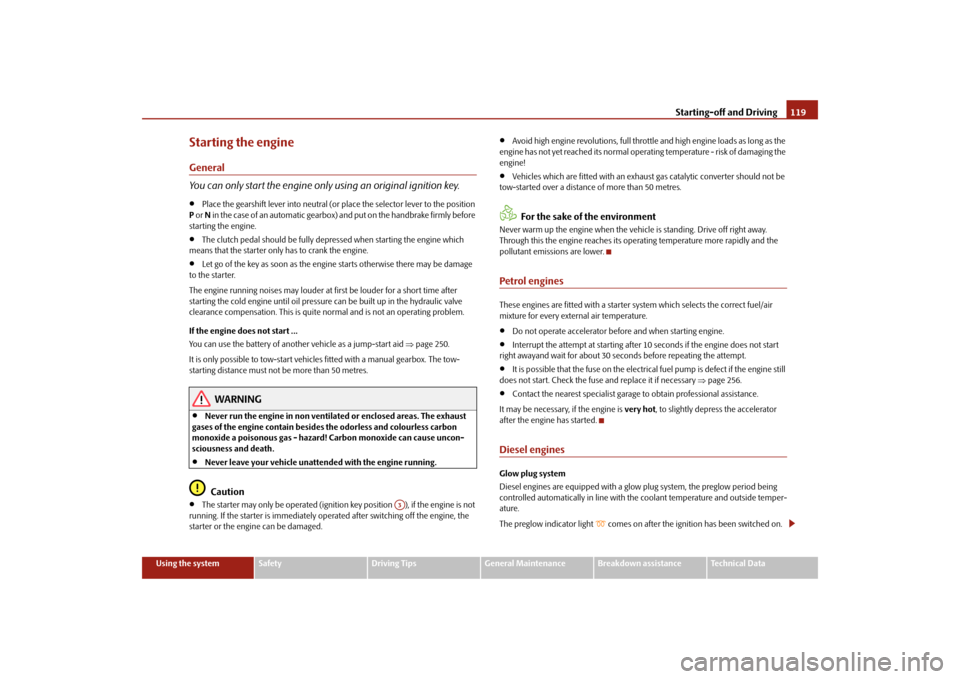
Starting-off and Driving
119
Using the system
Safety
Driving Tips
General Maintenance
Breakdown assistance
Technical Data
Starting the engineGeneral You can only start the engine only using an original ignition key.•
Place the gearshift lever into neutral (or place the selector lever to the position
P or N in the case of an automatic gearbox)
and put on the handbrake firmly before
starting the engine.•
The clutch pedal should be fully depressed when starting the engine which
means that the starter only
has to crank the engine.
•
Let go of the key as soon as the engine starts otherwise there may be damage
to the starter. The engine running noises may louder at
first be louder for
a short time after
starting the cold engine until oil pressure
can be built up in the hydraulic valve
clearance compensation. This is quite normal and is not an operating problem. If the engine does not start ... You can use the battery of anothe
r vehicle as a jump-start aid
⇒page 250.
It is only possible to tow-start vehicl
es fitted with a manual gearbox. The tow-
starting distance must not be more than 50 metres.
WARNING
•
Never run the engine in non ventilat
ed or enclosed areas. The exhaust
gases of the engine contain besides
the odorless and colourless carbon
monoxide a poisonous gas - hazard! Carbon monoxide can cause uncon- sciousness and death.•
Never leave your vehicle unattended with the engine running.Caution
•
The starter may only be operated (ignition key position ), if the engine is not
running. If the starter is immediately oper
ated after switching off the engine, the
starter or the engine can be damaged.
•
Avoid high engine revolutions, full throttl
e and high engine loads as long as the
engine has not yet reached it
s normal operating temperature - risk of damaging the
engine!•
Vehicles which are fitted wi
th an exhaust gas catalyti
c converter should not be
tow-started over a distance of more than 50 metres.
For the sake of the environment
Never warm up the engine when the vehi
cle is standing. Drive off right away.
Through this the engine reaches its operating temperature more rapidly and the pollutant emissions are lower.Petrol enginesThese engines are fitted with a starter system which selects the correct fuel/air mixture for every external air temperature.•
Do not operate accelerator before and when starting engine.
•
Interrupt the attempt at starting after
10 seconds if the engine does not start
right awayand wait for about 30 se
conds before repeating the attempt.
•
It is possible that the fuse on the electric
al fuel pump is defect if the engine still
does not start. Check the fuse and replace it if necessary
⇒page 256.
•
Contact the nearest specialist garage to obtain professional assistance.
It may be necessary, if the engine is
very hot
, to slightly depress the accelerator
after the engine has started.Diesel enginesGlow plug system Diesel engines are equipped with a glow
plug system, the preglow period being
controlled automatically in
line with the coolant temperature and outside temper-
ature. The preglow indicator light
comes on after the ignition has been switched on.
A3
s2dk.1.book Page 119 Wednesday, April 8, 2009 12:23 PM
Page 121 of 294
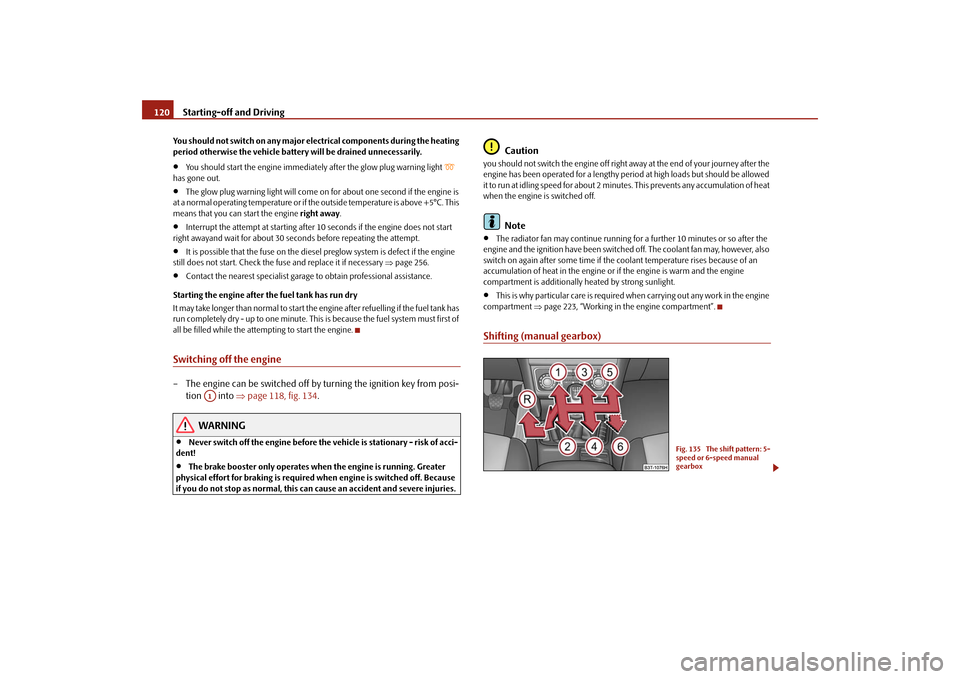
Starting-off and Driving
120
You should not switch on any major elec
trical components during the heating
period otherwise the vehicle battery
will be drained unnecessarily.
•
You should start the engine immediately after the glow plug warning light
has gone out.•
The glow plug warning light will come on for about one second if the engine is
at a normal operating temperature or if the outside temperature is above +5°C. This means that you can start the engine
right away
.
•
Interrupt the attempt at starting after 10 seconds if the engine does not start
right awayand wait for about 30 se
conds before repeating the attempt.
•
It is possible that the fuse on the diesel
preglow system is defect if the engine
still does not start. Check the fuse and replace it if necessary
⇒page 256.
•
Contact the nearest specialist garage to obtain professional assistance.
Starting the engine after the fuel tank has run dry It may take longer than normal to start the
engine after refuelling
if the fuel tank has
run completely dry - up to one minute. This is because the fuel system must first of all be filled while the attempting to start the engine.Switching off the engine– The engine can be swit
ched off by turning the ignition key from posi-
tion into
⇒
page 118, fig. 134
.
WARNING
•
Never switch off the engine before the
vehicle is stationary - risk of acci-
dent!•
The brake booster only operates when the engine is running. Greater
physical effort for braking is required
when engine is switched off. Because
if you do not stop as normal, this can cause an accident and severe injuries.
Caution
you should not switch the engine off right
away at the end of your journey after the
engine has been operated for a lengthy peri
od at high loads but should be allowed
it to run at idling speed for about 2 minut
es. This prevents any accumulation of heat
when the engine is switched off.
Note
•
The radiator fan may continue running fo
r a further 10 minutes or so after the
engine and the ignition have
been switched off. The coolant fan may, however, also
switch on again after some time if the coolant temperature rises because of an accumulation of heat in the engine or
if the engine is warm and the engine
compartment is additionally
heated by strong sunlight.
•
This is why particular care is required when carrying out any work in the engine
compartment
⇒page 223, “Working in the engine compartment”.
Shifting (manual gearbox)
A1
Fig. 135 The shift pattern: 5- speed or 6-speed manual gearbox
s2dk.1.book Page 120 Wednesday, April 8, 2009 12:23 PM
Page 126 of 294
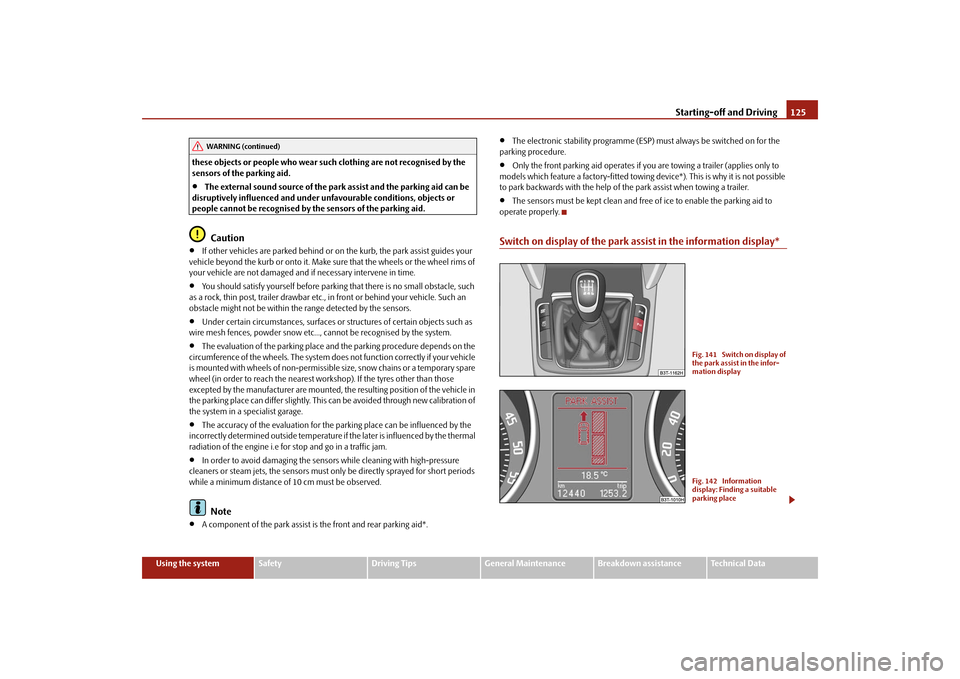
Starting-off and Driving
125
Using the system
Safety
Driving Tips
General Maintenance
Breakdown assistance
Technical Data
these objects or people who wear such clothing are not recognised by the sensors of the parking aid.•
The external sound source of the park assist and the parking aid can be
disruptively influenced and under unfavourable conditions, objects or people cannot be recognised by the sensors of the parking aid.
Caution
•
If other vehicles are parked
behind or on the kurb, the park assist guides your
vehicle beyond the kurb or onto it. Make sure that the wheels or the wheel rims of your vehicle are not damaged and
if necessary intervene in time.
•
You should satisfy yourself before parkin
g that there is no small obstacle, such
as a rock, thin post, trailer drawbar etc., in
front or behind your vehicle. Such an
obstacle might not be within the range detected by the sensors.•
Under certain circumstances, surfaces or structures of certain objects such as
wire mesh fences, powder snow etc...,
cannot be recognised by the system.
•
The evaluation of the parking place and the parking procedure depends on the
circumference of the wheels. The system does
not function correctly if your vehicle
is mounted with wheels of non-permissible size, snow chains or a temporary spare wheel (in order to reach the nearest workshop). If the tyres other than those excepted by the manufacturer are mounted,
the resulting position of the vehicle in
the parking place can differ slightly. This
can be avoided throug
h new calibration of
the system in a specialist garage.•
The accuracy of the evaluation for the
parking place can be influenced by the
incorrectly determined outside temperature if
the later is influenced by the thermal
radiation of the engine i.e for stop and go in a traffic jam.•
In order to avoid damaging the sensor
s while cleaning with high-pressure
cleaners or steam jets, the sensors must on
ly be directly sprayed for short periods
while a minimum distance of 10 cm must be observed.
Note
•
A component of the park assist is
the front and rear parking aid*.
•
The electronic stability programme (ESP)
must always be switched on for the
parking procedure.•
Only the front parking aid operates if you are towing a trailer (applies only to
models which feature a factory-fitted towing device*). This is why it is not possible to park backwards with the help of th
e park assist when
towing a trailer.
•
The sensors must be kept clean and free of ice to enable the parking aid to
operate properly.Switch on display of the park assist in the information display*
WARNING (continued)
Fig. 141 Switch on display of the park assist in the infor-mation displayFig. 142 Information display: Finding a suitable parking place
s2dk.1.book Page 125 Wednesday, April 8, 2009 12:23 PM
Page 129 of 294
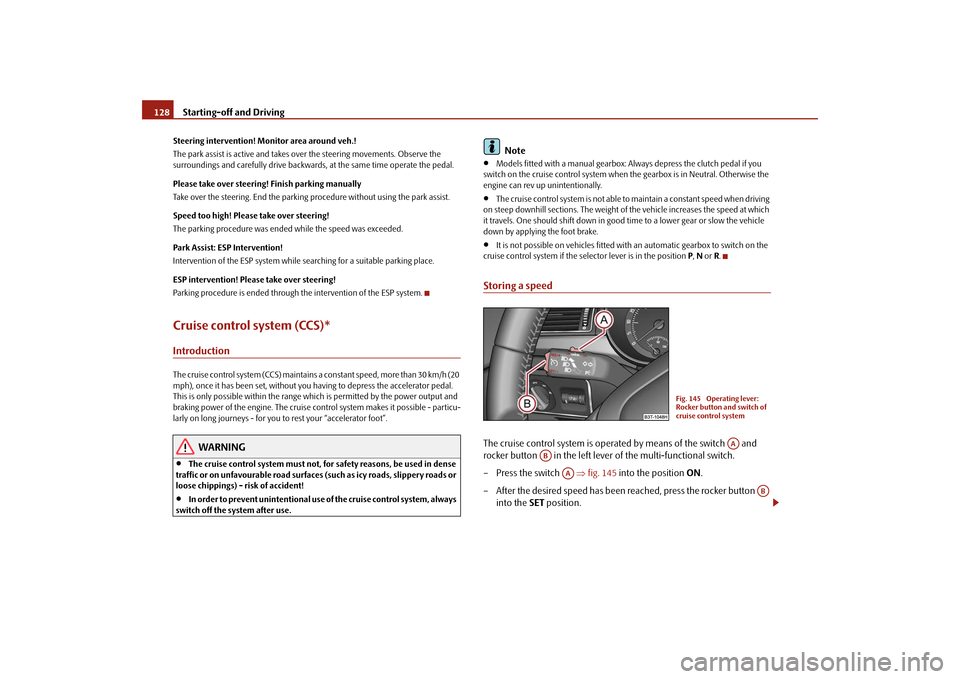
Starting-off and Driving
128
Steering intervention! Moni
tor area around veh.!
The park assist is active and takes over the steering movements. Observe the surroundings and carefully drive backward
s, at the same time operate the pedal.
Please take over steering! Finish parking manually Take over the steering. End the parking procedure without using the park assist. Speed too high! Please take over steering! The parking procedure was ended while the speed was exceeded. Park Assist: ESP Intervention! Intervention of the ESP system while searching for a suitable parking place. ESP intervention! Please take over steering! Parking procedure is ended through the intervention of the ESP system.Cruise control system (CCS)*IntroductionThe cruise control system (CCS) maintains a constant speed, more than 30 km/h (20 mph), once it has been set, without you
having to depress th
e accelerator pedal.
This is only possible within the range which is permitted by the power output and braking power of the engine. The cruise control system makes it possible - particu- larly on long journeys - for you to rest your “accelerator foot”.
WARNING
•
The cruise control system must not, for safety reasons, be used in dense
traffic or on unfavourable road surfaces
(such as icy roads, slippery roads or
loose chippings) - risk of accident!•
In order to prevent unintentional use
of the cruise control system, always
switch off the system after use.
Note
•
Models fitted with a manual gearbox: Al
ways depress the clutch pedal if you
switch on the cruise control system when
the gearbox is in Neutral. Otherwise the
engine can rev up unintentionally.•
The cruise control system is not able to maintain a constant speed when driving
on steep downhill sections. The weight of the vehicle increases the speed at which it travels. One should shift down in good
time to a lower gear or slow the vehicle
down by applying the foot brake.•
It is not possible on vehicl
es fitted with an automati
c gearbox to switch on the
cruise control system if the selector lever is in the position
P, N or R.
Storing a speedThe cruise control system is operated by means of the switch and rocker button in the left lever of the multi-functional switch. – Press the switch
⇒
fig. 145
into the position
ON
.
– After the desired speed has been reached, press the rocker button
into the
SET
position.
Fig. 145 Operating lever: Rocker button and switch of cruise control system
AA
AB
AA
AB
s2dk.1.book Page 128 Wednesday, April 8, 2009 12:23 PM
Page 132 of 294
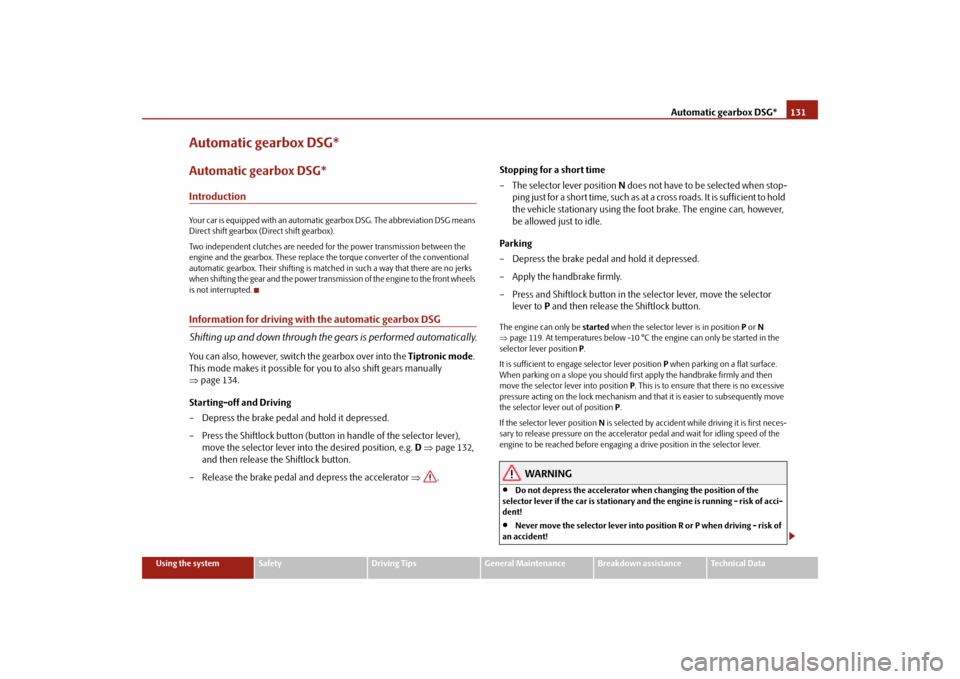
Automatic gearbox DSG*
131
Using the system
Safety
Driving Tips
General Maintenance
Breakdown assistance
Technical Data
Automatic gearbox DSG*Automatic gearbox DSG*IntroductionYour car is equipped with an automatic
gearbox DSG. The abbr
eviation DSG means
Direct shift gearbox (Direct shift gearbox). Two independent clutches are needed for the power transmission between the engine and the gearbox. These replace the torque converter of the conventional automatic gearbox. Their shifting is matched in such a way that there are no jerks when shifting the gear and the power transmission of the engine to the front wheels is not interrupted.Information for driving with the automatic gearbox DSG Shifting up and down through the gears is performed automatically.You can also, however, switch
the gearbox over into the
Tiptronic mode
.
This mode makes it possible for
you to also shift gears manually
⇒
page 134.
Starting-off and Driving – Depress the brake pedal and hold it depressed. – Press the Shiftlock button (button
in handle of the selector lever),
move the selector lever into the desired position, e.g.
D ⇒
page 132,
and then release the Shiftlock button.
– Release the brake pedal and depress the accelerator
⇒
.
Stopping for a short time – The selector lever position
N does not have to be selected when stop-
ping just for a short time, such as at a
cross roads. It is sufficient to hold
the vehicle stationary using the foot
brake. The engine can, however,
be allowed just to idle.
Parking – Depress the brake pedal and hold it depressed. – Apply the handbrake firmly. – Press and Shiftlock button in the
selector lever, move the selector
lever to
P and then release the Shiftlock button.
The engine can only be
started
when the selector lever is in position
P or N
⇒ page 119. At temperatures below -10 °C the engine can only be started in the selector lever position
P.
It is sufficient to engage
selector lever position
P when parking on a flat surface.
When parking on a slope you should first apply the handbrake firmly and then move the selector le
ver into position
P. This is to ensure that there is no excessive
pressure acting on the lock mechanism and
that it is easier to subsequently move
the selector lever out of position
P.
If the selector lever position
N is selected by accident while driving it is first neces-
sary to release pressure on the accelerato
r pedal and wait for idling speed of the
engine to be reached before engaging a drive position in the selector lever.
WARNING
•
Do not depress the accelerator when changing the position of the
selector lever if the car is stationary an
d the engine is running - risk of acci-
dent!•
Never move the selector lever into position R or P when driving - risk of
an accident!
s2dk.1.book Page 131 Wednesday, April 8, 2009 12:23 PM